Determining how much a gold coin is worth involves understanding various factors, from its gold content to its numismatic value. At HOW.EDU.VN, we provide expert guidance to help you accurately assess the value of your gold coins. Discover the key factors that influence the worth of gold coins and learn how to navigate the complexities of coin valuation. Explore insights into gold prices, coin collecting, and precious metal investing.
1. Understanding the Intrinsic Value: The Gold Content
1.1. Calculating Melt Value
The melt value of a gold coin is the value of the gold it contains if it were melted down. This is a baseline figure, primarily determined by the current spot price of gold. To calculate the melt value:
- Determine the coin’s weight in grams.
- Identify the coin’s gold purity (e.g., 90% gold, .9999 fine gold).
- Multiply the coin’s weight by its purity to find the actual gold weight (AGW).
- Convert the AGW to troy ounces (1 gram = 0.0321507 troy ounces).
- Multiply the troy ounces of gold by the current spot price of gold per troy ounce.
For instance, a U.S. Gold Eagle coin weighs 33.931 grams and is 91.67% gold. Therefore, its AGW is approximately 1 troy ounce. If gold is priced at $3,432.37 per troy ounce, the melt value of the coin is $3,432.37. These calculations are essential when considering gold investments.
1.2. Spot Price of Gold and Its Impact
The spot price of gold is the current market price at which gold can be bought or sold for immediate delivery. It fluctuates based on global economic factors, geopolitical events, and market sentiment. According to research from the World Gold Council, gold prices often increase during times of economic uncertainty, making it a safe-haven asset.
1.2.1. Monitoring Gold Prices
Staying informed about the spot price of gold is crucial for assessing the melt value of gold coins. Reliable sources include:
- Financial News Websites: Bloomberg, Reuters, and MarketWatch provide real-time gold prices.
- Precious Metals Dealers: APMEX and Kitco offer current gold prices and market analysis.
- Specialized Coin Websites: NGC Coin Explorer provides updated melt values for various U.S. gold coins, helping collectors and investors track their investments accurately.
1.3. Purity and Weight Variations in Different Gold Coins
Gold coins come in various purities and weights, affecting their melt values significantly. Here’s a comparison of some common U.S. gold coins:
| Coin | Gold Purity | Weight (g) | AGW (oz) |
|---|---|---|---|
| Gold Eagle $50 – One Ounce | 91.67% | 33.931 | 1 |
| Buffalo $50 – One Ounce | 99.99% | 31.105 | 1 |
| Liberty Head $20 | 90% | 33.436 | 0.9675 |
| Saint-Gaudens $20 | 90% | 33.436 | 0.9675 |
| First Spouse $10 – 1/2 Ounce | 99.99% | 15.552 | 0.5 |
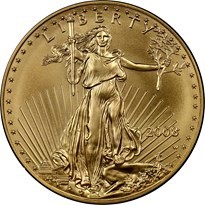
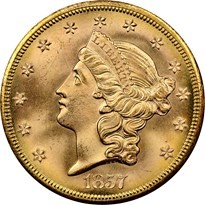
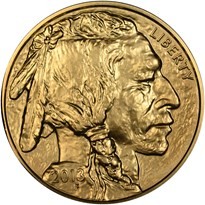
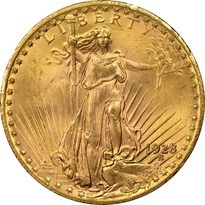
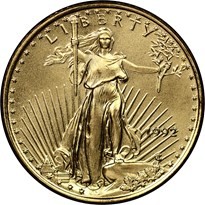
Understanding these variations helps in accurately calculating the intrinsic value of each coin.
2. Factors Influencing Numismatic Value
2.1. Rarity and Scarcity
Rarity is a primary factor determining the numismatic value of a gold coin. Coins with low mintage numbers or those that survived in limited quantities are highly sought after by collectors. For example, the 1933 Saint-Gaudens Double Eagle is one of the rarest and most valuable U.S. gold coins due to its unique history and limited availability.
2.1.1. Mintage Figures
Mintage figures, the number of coins initially produced, provide insight into a coin’s potential rarity. Coins with lower mintage are generally more valuable. Collectors often refer to historical records from the U.S. Mint and other authoritative sources to verify mintage numbers.
2.2. Condition and Grading
The condition of a gold coin significantly impacts its value. Coins are graded on a scale that ranges from Poor (P-1) to Perfect Uncirculated (MS-70). Higher grades indicate better condition and, consequently, higher value.
2.2.1. Understanding Grading Scales
Professional grading services like NGC (Numismatic Guaranty Corporation) and PCGS (Professional Coin Grading Service) assess a coin’s condition based on factors such as surface preservation, strike quality, and luster. According to NGC, a coin graded MS-70 shows no imperfections even under magnification.
2.2.2. Impact of Wear and Tear
Wear and tear can significantly reduce a coin’s value. Scratches, dents, and discoloration are common issues that affect a coin’s grade. Coins in circulated condition generally have lower numismatic value compared to uncirculated specimens.
2.3. Historical Significance
Coins with significant historical importance often command higher prices. Coins associated with key historical events, influential figures, or unique periods in history can be particularly valuable.
2.3.1. Coins as Historical Artifacts
Gold coins can serve as tangible links to the past, offering insights into the economic, political, and social conditions of their time. For instance, coins from the California Gold Rush era are prized for their connection to this pivotal event in American history.
3. Types of U.S. Gold Coins and Their Values
3.1. Liberty Head Gold Coins
The Liberty Head series includes several denominations, each with its own historical significance and collector appeal:
- Liberty Head Gold Dollar (1849-1854): These small gold coins are relatively scarce and can be valuable, especially in higher grades.
- Liberty Head $2.50 (1840-1907): Also known as Quarter Eagles, these coins are popular among collectors due to their historical significance.
- Liberty Head $5 (1839-1908): Known as Half Eagles, these coins are more common but still valuable, especially those from earlier dates.
- Liberty Head $10 (1838-1907): Known as Eagles, these coins are larger and more substantial, making them desirable for collectors and investors.
- Liberty Head $20 (1849-1907): Known as Double Eagles, these coins are among the most widely collected U.S. gold coins due to their size and historical importance.
3.2. Indian Head Gold Coins
The Indian Head series is celebrated for its distinctive designs and historical context:
- Indian Head Gold Dollar (Type Two & Three) (1854-1889): These coins are valued for their unique design and scarcity, especially the Type Two coins.
- Indian Head $2.50 (1908-1929): These coins feature an incuse design, making them stand out among U.S. gold coins.
- Indian Head $5 (1908-1929): Similar to the $2.50, these coins also feature an incuse design and are popular among collectors.
- Indian Head $10 (1907-1933): These coins are known for their bold design and historical significance, particularly those from the later years of the series.
3.3. Saint-Gaudens Gold Coins
The Saint-Gaudens Double Eagle is renowned for its artistic design and historical importance:
- Saint-Gaudens $20 (1907-1933): Considered one of the most beautiful U.S. coins ever produced, the Saint-Gaudens Double Eagle is highly sought after by collectors.
3.4. Modern Gold Coins: American Eagles and Buffaloes
Modern U.S. gold coins are popular for both their gold content and collector appeal:
- Gold Eagle $5, $10, $25, $50 (1986-Date): These coins are available in various sizes and are popular for investment purposes.
- Buffalo $50 (2006-Date): These coins are made of .9999 fine gold and are highly valued for their purity.
- First Spouse $10 (2007-Date): These coins commemorate the spouses of U.S. presidents and are popular among collectors.
- Modern Commemorative $5 (1982-Date): These coins celebrate various events and figures in American history.
4. Evaluating Gold Coin Value: A Step-by-Step Guide
4.1. Identify the Coin
The first step in evaluating a gold coin is to accurately identify it. This includes determining the coin’s denomination, series, and year of minting. Resources like the NGC Coin Explorer can be invaluable for this step.
4.2. Determine Gold Content
Once the coin is identified, determine its gold content. This involves finding out the coin’s weight and purity. This information is typically available in coin catalogs or on reputable numismatic websites.
4.3. Check the Spot Price of Gold
The spot price of gold is a key factor in determining the coin’s melt value. Monitor the spot price of gold from reliable sources such as financial news websites or precious metals dealers.
4.4. Calculate Melt Value
Use the formula described earlier to calculate the coin’s melt value:
- Find the coin’s weight in grams.
- Determine the coin’s gold purity.
- Calculate the actual gold weight (AGW) in troy ounces.
- Multiply the AGW by the current spot price of gold per troy ounce.
4.5. Assess Numismatic Value
Assessing the numismatic value involves considering factors such as rarity, condition, and historical significance. This step often requires consulting with a professional numismatist or submitting the coin to a grading service like NGC or PCGS.
4.6. Consult Price Guides and Expert Opinions
Price guides such as the NGC US Coin Price Guide provide estimated values for coins in different grades. However, these guides should be used as a starting point. Consulting with a professional numismatist can provide a more accurate assessment of the coin’s value.
5. Common Mistakes in Gold Coin Valuation
5.1. Overlooking Numismatic Value
One of the most common mistakes in gold coin valuation is focusing solely on the melt value and overlooking the numismatic value. A coin’s rarity, condition, and historical significance can significantly increase its value beyond its gold content.
5.2. Misidentifying the Coin
Accurate identification is crucial for proper valuation. Misidentifying the coin can lead to incorrect assessments of its rarity and historical significance.
5.3. Inaccurate Grading
Grading a coin accurately requires expertise and experience. Attempting to grade a coin without proper knowledge can lead to overestimating its condition and value.
5.4. Ignoring Market Trends
The value of gold coins can be influenced by market trends and collector demand. Ignoring these trends can result in inaccurate valuations.
6. Selling Gold Coins: Maximizing Your Return
6.1. Understanding Your Options
When selling gold coins, you have several options, each with its own advantages and disadvantages:
- Selling to a Local Coin Dealer: This option offers convenience and the opportunity for face-to-face negotiations.
- Selling at Auction: Auctions can attract serious collectors and potentially result in higher prices, especially for rare or high-grade coins.
- Selling Online: Online marketplaces such as eBay can provide access to a wider audience, but they also come with risks and fees.
- Selling to a Precious Metals Refiner: This option is best for coins with minimal numismatic value, as you will primarily receive the melt value.
6.2. Preparing Your Coins for Sale
Before selling your coins, it’s important to prepare them properly:
- Research the Market: Understand the current market value of your coins.
- Clean Coins Carefully: Avoid harsh cleaning methods that can damage the coin’s surface.
- Document the Coins: Keep detailed records of each coin, including its identification, condition, and estimated value.
6.3. Negotiating the Best Price
Negotiating the best price requires knowledge and confidence:
- Know Your Coin’s Value: Be prepared to justify your asking price.
- Get Multiple Offers: Compare offers from different buyers.
- Be Willing to Walk Away: Don’t be afraid to decline an offer that doesn’t meet your expectations.
7. Investing in Gold Coins: A Strategic Approach
7.1. Diversification
Investing in gold coins can be a strategic way to diversify your investment portfolio. Gold often performs well during economic downturns, making it a valuable hedge against inflation and market volatility.
7.2. Long-Term Value
Gold coins can offer long-term value appreciation, especially for rare and high-grade specimens. However, it’s important to approach gold coin investing with a long-term perspective and to be prepared for fluctuations in the market.
7.3. Factors to Consider
Before investing in gold coins, consider the following factors:
- Budget: Determine how much you are willing to invest.
- Investment Goals: Define your investment goals, such as long-term appreciation or capital preservation.
- Storage: Consider how you will store your gold coins safely and securely.
8. Expert Insights from HOW.EDU.VN
8.1. The Expertise You Need
At HOW.EDU.VN, we understand the complexities of valuing gold coins. Our team of experienced numismatists and financial experts provides comprehensive guidance to help you make informed decisions.
8.2. Personalized Consultations
We offer personalized consultations tailored to your specific needs. Whether you’re a seasoned collector or a first-time investor, our experts can provide the insights and advice you need to succeed.
8.3. Stay Informed
Stay up-to-date with the latest market trends and expert analysis by visiting HOW.EDU.VN. Our resources include articles, videos, and interactive tools to help you navigate the world of gold coins.
9. Connecting with Experts at HOW.EDU.VN
9.1. Addressing Your Challenges
Are you finding it hard to identify the true value of your gold coins? Do you worry about overpaying or underselling? At HOW.EDU.VN, we connect you with top-tier experts who provide tailored guidance to address your unique challenges.
9.2. Tailored Advice from Leading Ph.D.s
Our team of over 100 Ph.D.s offers personalized advice to ensure you make informed decisions. We provide in-depth analysis of your gold coins, considering both their intrinsic value and numismatic potential.
9.3. Secure and Confidential Consultations
We understand the importance of privacy and security. All consultations are conducted with the utmost confidentiality, ensuring your information is protected.
10. Frequently Asked Questions (FAQ)
10.1. What is the melt value of a gold coin?
The melt value is the intrinsic value of the gold in a coin, based on the current spot price of gold.
10.2. How do I calculate the melt value of a gold coin?
Determine the coin’s weight and purity, calculate the actual gold weight (AGW) in troy ounces, and multiply the AGW by the current spot price of gold.
10.3. What factors affect the numismatic value of a gold coin?
Rarity, condition, and historical significance are key factors influencing numismatic value.
10.4. Where can I find the spot price of gold?
Reliable sources include financial news websites, precious metals dealers, and specialized coin websites.
10.5. How important is the condition of a gold coin?
The condition of a gold coin significantly impacts its value. Higher grades indicate better condition and higher value.
10.6. Should I clean my gold coins before selling them?
Avoid harsh cleaning methods that can damage the coin’s surface. Gentle cleaning with a soft cloth may be acceptable.
10.7. What are the best options for selling gold coins?
Options include selling to a local coin dealer, at auction, online, or to a precious metals refiner.
10.8. Is investing in gold coins a good idea?
Investing in gold coins can be a strategic way to diversify your investment portfolio and hedge against economic uncertainty.
10.9. How can HOW.EDU.VN help me with gold coin valuation?
HOW.EDU.VN provides expert guidance, personalized consultations, and up-to-date market analysis to help you make informed decisions.
10.10. What is the difference between melt value and numismatic value?
Melt value is the value of the gold content, while numismatic value is the value based on factors like rarity, condition, and historical significance.
Navigating the world of gold coin valuation can be complex, but with the right knowledge and expert guidance, you can make informed decisions and maximize your returns.
Don’t let the complexities of gold coin valuation overwhelm you. Contact HOW.EDU.VN today for personalized advice from our team of leading Ph.D.s. Whether you need help identifying, valuing, buying, or selling gold coins, we are here to provide the expertise you need. Reach out to us at 456 Expertise Plaza, Consult City, CA 90210, United States, or call +1 (310) 555-1212. Visit our website at how.edu.vn to learn more and schedule a consultation. Let us help you unlock the true value of your gold coins.
